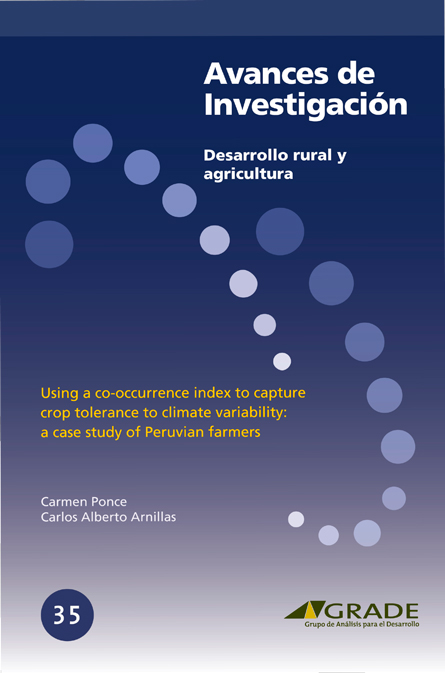Using a co-occurrence index to capture crop tolerance to climate variability: a case study of Peruvian farmers
| Year | : | 2018 |
|---|---|---|
| Author/s | : | Carmen Ponce, Carlos Alberto Arnillas |
| Area/s | : | Rural development and agriculture |
Ponce, Carmen y Carlos Alberto Arnillas (2018). Using a co-occurrence index to capture crop tolerance to climate variability: a case study of Peruvian farmers. Avance de Investigación, 35.
Peruvian small farmers in the Andes mountain region have historically faced wide climate variability (from year to year and within the crop growing season). Traditional knowledge and practices, including crop portfolio diversification and selection of tolerant crops, aim at safeguarding food security even in “bad” years when climate- or market-related risks materialize. In spite of this historical knowledge and experience, accelerated climate changes pose new challenges that farmers struggle to adjust to, especially due to a lack of timely information and financial and physical resources. Understanding how farmers are autonomously adapting is a pending need, to be able to inform policymakers about the bottlenecks and sustainable practices that can be strengthened to support efficient adaptation. This study focuses on one type of adaptation: selecting crops that seem to be more tolerant to variable climate conditions. The authors use Fridley et al.’s co-occurrence index (2007), which measures a species’ ecological niche breadth, to estimate the relative tolerance of crops to a range of environmental conditions. Using census data (district panels from 1994 and 2012), they estimate crop tolerance for 252 crops cultivated in diverse environmental conditions throughout the country, ranging from the Andean Highlands to Coastal and Amazon Rainforest regions. Researchers test the suitability of the crop index for capturing crop tolerance to variable climate conditions (maximum, minimum, and average temperatures, and precipitation) using two definitions of climate variability. The authors find the expected positive correlation between the index and climate variability, which confirms the index’s suitability for capturing relative tolerance to climate variability. They also apply the index empirically to explore the role of intraseasonal climate variability (during the growing season) on the relative tolerance of farmers’ crop portfolio. Although further analysis is needed to fully model farmers’ decisions, our preliminary estimates show that farmers adjust their portfolios to include more tolerant crops when facing increased climate variability.






